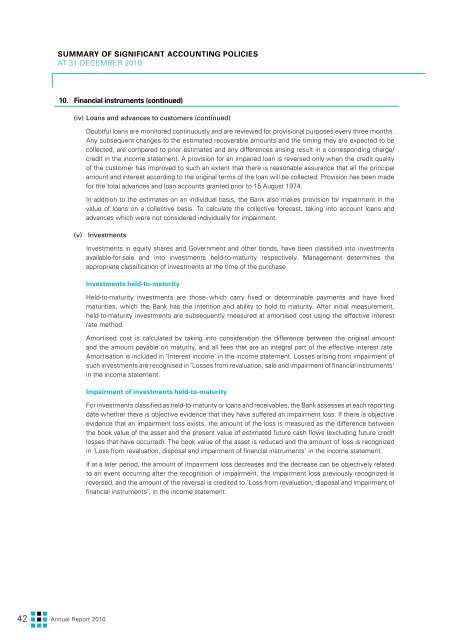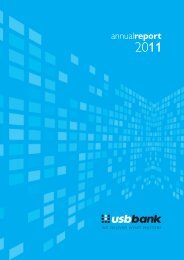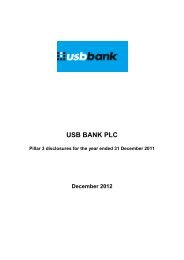Annual Report 2010 (PDF) - USB Bank
Annual Report 2010 (PDF) - USB Bank
Annual Report 2010 (PDF) - USB Bank
Create successful ePaper yourself
Turn your PDF publications into a flip-book with our unique Google optimized e-Paper software.
Summary of Significant Accounting Policies<br />
at 31 December <strong>2010</strong><br />
10. Financial instruments (continued)<br />
(iv) Loans and advances to customers (continued)<br />
Doubtful loans are monitored continuously and are reviewed for provisional purposes every three months.<br />
Any subsequent changes to the estimated recoverable amounts and the timing they are expected to be<br />
collected, are compared to prior estimates and any differences arising result in a corresponding charge/<br />
credit in the income statement. A provision for an impaired loan is reversed only when the credit quality<br />
of the customer has improved to such an extent that there is reasonable assurance that all the principal<br />
amount and interest according to the original terms of the loan will be collected. Provision has been made<br />
for the total advances and loan accounts granted prior to 15 August 1974.<br />
In addition to the estimates on an individual basis, the <strong>Bank</strong> also makes provision for impairment in the<br />
value of loans on a collective basis. To calculate the collective forecast, taking into account loans and<br />
advances which were not considered individually for impairment.<br />
(v) Investments<br />
Investments in equity shares and Government and other bonds, have been classified into investments<br />
available-for-sale and into investments held-to-maturity respectively. Management determines the<br />
appropriate classification of investments at the time of the purchase.<br />
Investments held-to-maturity<br />
Held-to-maturity investments are those which carry fixed or determinable payments and have fixed<br />
maturities, which the <strong>Bank</strong> has the intention and ability to hold to maturity. After initial measurement,<br />
held-to-maturity investments are subsequently measured at amortised cost using the effective interest<br />
rate method.<br />
Amortised cost is calculated by taking into consideration the difference between the original amount<br />
and the amount payable on maturity, and all fees that are an integral part of the effective interest rate.<br />
Amortisation is included in ‘Interest income’ in the income statement. Losses arising from impairment of<br />
such investments are recognised in ‘Losses from revaluation, sale and impairment of financial instruments’<br />
in the income statement.<br />
Impairment of investments held-to-maturity<br />
For investments classified as held-to-maturity or loans and receivables, the <strong>Bank</strong> assesses at each reporting<br />
date whether there is objective evidence that they have suffered an impairment loss. If there is objective<br />
evidence that an impairment loss exists, the amount of the loss is measured as the difference between<br />
the book value of the asset and the present value of estimated future cash flows (excluding future credit<br />
losses that have occurred). The book value of the asset is reduced and the amount of loss is recognized<br />
in ‘Loss from revaluation, disposal and impairment of financial instruments’ in the income statement.<br />
If at a later period, the amount of impairment loss decreases and the decrease can be objectively related<br />
to an event occurring after the recognition of impairment, the impairment loss previously recognized is<br />
reversed, and the amount of the reversal is credited to ‘Loss from revaluation, disposal and impairment of<br />
financial instruments’, in the income statement.<br />
42<br />
Αnnual <strong>Report</strong> <strong>2010</strong>






